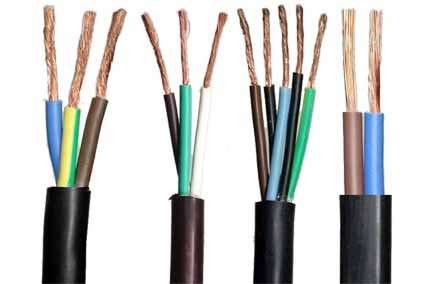TPE flexible cable manufacturer
TPE heat-shrinkable rubber flexible cables are mainly divided into: TPE heat-shrinkable rubber flexible (unshielded) cables, TPE heat-shrinkable rubber flexible shielded cables.

Feature
Conductor: single/multi-strand copper wire, multiple-strand tinned/silver-plated copper wire
Filling: tensile materials such as cotton thread, nylon, bulletproof silk (cavlar fiber), etc.
Sheath: TPE
performance
It has excellent properties of softness, elasticity, environmental protection, low temperature resistance and good touch.
application
TPE heat-shrinkable rubber flexible cables are widely used in the connection of power signals in industrial machinery and equipment, various sensors, transmission control systems, detection and measurement equipment, instrumentation, electronic equipment, medical equipment, household appliances, etc.
Application of TPE materials in wires and cables:
TPE combines the characteristics of plastic and rubber, and is known as the "third-generation synthetic rubber." In TPE, SBS styrene block copolymer occupies an important position. It is currently the world's largest production and fastest-growing environmentally friendly thermoplastic elastomer material that can replace PVC and soft vulcanized rubber.
The main performance requirements of TPE are the main performance requirements and applications of elastomers used in the outer covering and insulating layer of wires. Mainly used in electric wires are low-voltage or direct current, communication and other flexible wires, which require relatively low electrical performance. Usually the requirements are slightly different from the cables, mainly: Temperature resistance class, electrical properties (dielectric constant, voltage resistance class), mechanical properties (tensile strength, elongation), chemical properties (oil resistance), flame resistance and other requirements.

There are many types of thermoplastic elastomers used in cable jackets and insulating layers. Such as: Polyolefin-based thermoplastic elastomer (TPO), Styrene-based thermoplastic elastomer (SBC), Thermoplastic polyurethane elastomer (TPU), polyester thermoplastic elastomer (TPEE), etc. Among them, due to the excellent insulation resistance performance of TPO and SBC, they are mostly used in the outer jacket and insulation layer of cables; And TPU and TPEE are generally used for cable jackets.
The halogen-free flame-retardant thermoplastic elastomer is based on resin and rubber, and the composite material added with a halogen-free flame retardant contains a large amount of organic compounds and has a certain degree of flammability. At the same time, flame retardants can be added to prevent its burning. Flame retardants exert their flame retardant effects through several mechanisms, such as endothermic effect, covering effect, inhibition of chain reaction, and flame retardant effect of non-combustible gases. Most flame retardants achieve the purpose of flame retardancy through the joint action of several mechanisms.
The smoke and dust produced by PVC is relatively large, which does not meet the requirements for escape; The environmentally friendly PVC formula is not yet mature, and the cost requirements are also high. In terms of environmental protection, PVC materials cannot be compared with TPE and TPR. Low-smoke and halogen-free TPE products are used in large public places (metro stations, large shopping malls, etc.), with good electrical insulation, UV resistance and chemical resistance. It will not produce harmful substances when burned, there is a tendency to gradually replace PVC, and it may be mandatory to use halogen-free materials. Such as: TPE halogen-free flame-retardant cables, but also PE or EVA substrate connectors, switches, sockets, computer cables, mouse wheels, telephone lines, mobile phone housing antennas, electronic buttons, electrical support or bases, camera parts .

Feature
Conductor: single/multi-strand copper wire, multiple-strand tinned/silver-plated copper wire
Filling: tensile materials such as cotton thread, nylon, bulletproof silk (cavlar fiber), etc.
Sheath: TPE
performance
It has excellent properties of softness, elasticity, environmental protection, low temperature resistance and good touch.
application
TPE heat-shrinkable rubber flexible cables are widely used in the connection of power signals in industrial machinery and equipment, various sensors, transmission control systems, detection and measurement equipment, instrumentation, electronic equipment, medical equipment, household appliances, etc.
Application of TPE materials in wires and cables:
TPE combines the characteristics of plastic and rubber, and is known as the "third-generation synthetic rubber." In TPE, SBS styrene block copolymer occupies an important position. It is currently the world's largest production and fastest-growing environmentally friendly thermoplastic elastomer material that can replace PVC and soft vulcanized rubber.
The main performance requirements of TPE are the main performance requirements and applications of elastomers used in the outer covering and insulating layer of wires. Mainly used in electric wires are low-voltage or direct current, communication and other flexible wires, which require relatively low electrical performance. Usually the requirements are slightly different from the cables, mainly: Temperature resistance class, electrical properties (dielectric constant, voltage resistance class), mechanical properties (tensile strength, elongation), chemical properties (oil resistance), flame resistance and other requirements.

There are many types of thermoplastic elastomers used in cable jackets and insulating layers. Such as: Polyolefin-based thermoplastic elastomer (TPO), Styrene-based thermoplastic elastomer (SBC), Thermoplastic polyurethane elastomer (TPU), polyester thermoplastic elastomer (TPEE), etc. Among them, due to the excellent insulation resistance performance of TPO and SBC, they are mostly used in the outer jacket and insulation layer of cables; And TPU and TPEE are generally used for cable jackets.
The halogen-free flame-retardant thermoplastic elastomer is based on resin and rubber, and the composite material added with a halogen-free flame retardant contains a large amount of organic compounds and has a certain degree of flammability. At the same time, flame retardants can be added to prevent its burning. Flame retardants exert their flame retardant effects through several mechanisms, such as endothermic effect, covering effect, inhibition of chain reaction, and flame retardant effect of non-combustible gases. Most flame retardants achieve the purpose of flame retardancy through the joint action of several mechanisms.
Compared with other traditional wire and cable materials, what are the advantages of TPE?
Halogen-free flame retardant and low-smoke halogen-free are a big trend: recyclable, environmentally friendly, ROHS-compliant, and UL-compliant. Excellent processability: It can be processed at a temperature of 180~220℃, and the processing of TPE is the most convenient and energy-saving. Most thermoplastic elastomers do not require vulcanization or have a short vulcanization time, which can effectively save energy. Excellent heat resistance: The heat resistance of 136℃×168hr can be humanized by having both flexibility and surface smoothness. And human body compatibility can pass the physical property test: Such as tensile strength test, elongation test can pass electrical property testThe smoke and dust produced by PVC is relatively large, which does not meet the requirements for escape; The environmentally friendly PVC formula is not yet mature, and the cost requirements are also high. In terms of environmental protection, PVC materials cannot be compared with TPE and TPR. Low-smoke and halogen-free TPE products are used in large public places (metro stations, large shopping malls, etc.), with good electrical insulation, UV resistance and chemical resistance. It will not produce harmful substances when burned, there is a tendency to gradually replace PVC, and it may be mandatory to use halogen-free materials. Such as: TPE halogen-free flame-retardant cables, but also PE or EVA substrate connectors, switches, sockets, computer cables, mouse wheels, telephone lines, mobile phone housing antennas, electronic buttons, electrical support or bases, camera parts .





